The forkhead transcription factor FOXO3a increases phosphoinositide-3 kinase/Akt activity in drug-resistant leukemic cells through induction of PIK3CA expression
- PMID: 18644865
- PMCID: PMC2547013
- DOI: 10.1128/MCB.01265-07
The forkhead transcription factor FOXO3a increases phosphoinositide-3 kinase/Akt activity in drug-resistant leukemic cells through induction of PIK3CA expression
Abstract
The phosphoinositide-3 kinase (PI3K)/Akt signal pathway plays a key role in the tumorigenesis of many cancers and in the subsequent development of drug resistance. Using the K562 chronic myelogenous leukemia (CML) cell line and the doxorubicin-resistant derivative lines KD30 and KD225 as models, we observed that enhanced PI3K/Akt activity and the acquisition of chemoresistance correlated unexpectedly with the increased expression and nuclear accumulation of FOXO3a. Moreover, we found that the induction of FOXO3a activity in naïve K562 cells was sufficient to enhance PI3K/Akt activity and to confer resistance to the cytotoxic effects of doxorubicin. Conversely, the knockdown of endogenous FOXO3a expression reduced PI3K/Akt activity and sensitized these cells to doxorubicin. Further chromatin immunoprecipitation and promoter mutation analyses demonstrated that FOXO3a regulates the expression of the PI3K catalytic subunit p110alpha through the activation of a promoter region proximal to a novel untranslated exon upstream from the reported transcription start site of the p110alpha gene PIK3CA. As was the case for FOXO3a, the expression or knockdown of p110alpha was sufficient to amplify or reduce PI3K/Akt activity, respectively. Thus, our results suggest that the chronic activation of FOXO3a by doxorubicin in CML cells can enhance survival through a feedback mechanism that involves enhanced p110alpha expression and hyperactivation of the PI3K/Akt pathway.
Figures

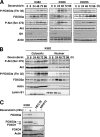
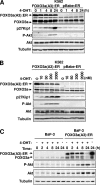
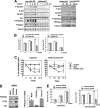
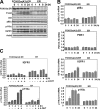
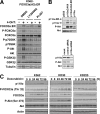
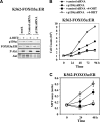
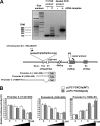

Similar articles
-
Doxorubicin activates FOXO3a to induce the expression of multidrug resistance gene ABCB1 (MDR1) in K562 leukemic cells.Mol Cancer Ther. 2008 Mar;7(3):670-8. doi: 10.1158/1535-7163.MCT-07-0397. Mol Cancer Ther. 2008. PMID: 18347152
-
Constitutively nuclear FOXO3a localization predicts poor survival and promotes Akt phosphorylation in breast cancer.PLoS One. 2010 Aug 20;5(8):e12293. doi: 10.1371/journal.pone.0012293. PLoS One. 2010. PMID: 20808831 Free PMC article.
-
Upregulation of miR-181c inhibits chemoresistance by targeting ST8SIA4 in chronic myelocytic leukemia.Oncotarget. 2016 Sep 13;7(37):60074-60086. doi: 10.18632/oncotarget.11054. Oncotarget. 2016. PMID: 27527856 Free PMC article.
-
Combating TKI resistance in CML by inhibiting the PI3K/Akt/mTOR pathway in combination with TKIs: a review.Med Oncol. 2021 Jan 16;38(1):10. doi: 10.1007/s12032-021-01462-5. Med Oncol. 2021. PMID: 33452624 Review.
-
Role and regulation of the forkhead transcription factors FOXO3a and FOXM1 in carcinogenesis and drug resistance.Chin J Cancer. 2013 Jul;32(7):365-70. doi: 10.5732/cjc.012.10277. Epub 2013 May 27. Chin J Cancer. 2013. PMID: 23706767 Free PMC article. Review.
Cited by
-
TRIM24 promotes glioma progression and enhances chemoresistance through activation of the PI3K/Akt signaling pathway.Oncogene. 2015 Jan 29;34(5):600-10. doi: 10.1038/onc.2013.593. Epub 2014 Jan 27. Oncogene. 2015. PMID: 24469053
-
FoxO transcription factors in cancer metabolism.Semin Cancer Biol. 2018 Jun;50:65-76. doi: 10.1016/j.semcancer.2018.01.004. Epub 2018 Jan 5. Semin Cancer Biol. 2018. PMID: 29309929 Free PMC article. Review.
-
Genes That Extend Lifespan May Do So by Mitigating the Increased Risk of Death Posed by Having Hypertension.Am J Hypertens. 2023 Nov 15;36(12):631-640. doi: 10.1093/ajh/hpad070. Am J Hypertens. 2023. PMID: 37561089 Free PMC article.
-
FOXP1 acts through a negative feedback loop to suppress FOXO-induced apoptosis.Cell Death Differ. 2013 Sep;20(9):1219-29. doi: 10.1038/cdd.2013.81. Epub 2013 Jul 5. Cell Death Differ. 2013. PMID: 23832113 Free PMC article.
-
Control of Oxidative Stress in Cancer Chemoresistance: Spotlight on Nrf2 Role.Antioxidants (Basel). 2021 Mar 25;10(4):510. doi: 10.3390/antiox10040510. Antioxidants (Basel). 2021. PMID: 33805928 Free PMC article. Review.
References
-
- Birkenkamp, K. U., A. Essafi, K. E. van der Vos, M. da Costa, R. C. Hui, F. Holstege, L. Koenderman, E. W. Lam, and P. J. Coffer. 2007. FOXO3a induces differentiation of Bcr-Abl-transformed cells through transcriptional down-regulation of Id1. J. Biol. Chem. 2822211-2220. - PubMed
-
- Brunet, A., L. B. Sweeney, J. F. Sturgill, K. F. Chua, P. L. Greer, Y. Lin, H. Tran, S. E. Ross, R. Mostoslavsky, H. Y. Cohen, L. S. Hu, H. L. Cheng, M. P. Jedrychowski, S. P. Gygi, D. A. Sinclair, F. W. Alt, and M. E. Greenberg. 2004. Stress-dependent regulation of FOXO transcription factors by the SIRT1 deacetylase. Science 3032011-2015. - PubMed
-
- Charvet, C., I. Alberti, F. Luciano, A. Jacquel, A. Bernard, P. Auberger, and M. Deckert. 2003. Proteolytic regulation of Forkhead transcription factor FOXO3a by caspase-3-like proteases. Oncogene 224557-4568. - PubMed
Publication types
MeSH terms
Substances
Grants and funding
LinkOut - more resources
Full Text Sources
Other Literature Sources
Medical
Research Materials
Miscellaneous
